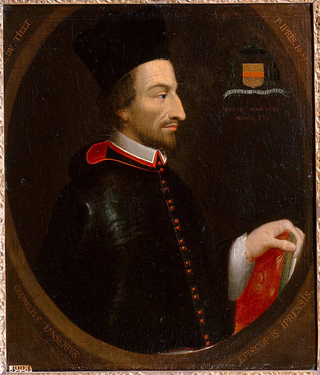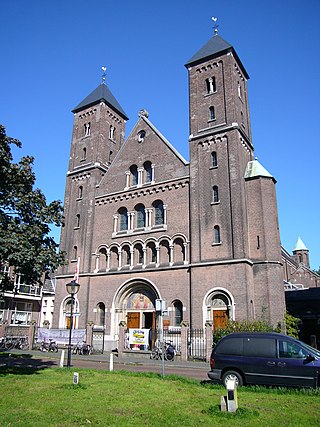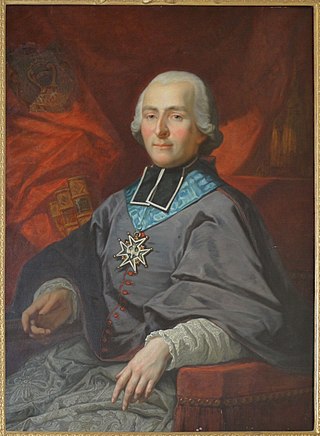
Pope Clement XI, born Giovanni Francesco Albani, was head of the Catholic Church and ruler of the Papal States from 23 November 1700 to his death in March 1721.

Pope Innocent XI, born Benedetto Odescalchi, was head of the Catholic Church and ruler of the Papal States from 21 September 1676 to his death, on 1689.

Jansenism was an early modern theological movement within Catholicism, primarily active in the Kingdom of France, that arose in an attempt to reconcile the theological concepts of free will and divine grace. Jansenists claimed to profess the true doctrine of grace as put forth by Augustine of Hippo. In 1653, Pope Innocent X promulgated the bull Cum occasione, which condemned five errors attributed to Jansenism, including the idea that Christ did not die or shed his blood for all men.

Cornelius Jansen was the Dutch Catholic bishop of Ypres in Flanders and the father of a theological movement known as Jansenism.

The Old Catholic Church of the Netherlands, sometimes Jansenist Church of Holland, is an Old Catholic jurisdiction originating from the Archdiocese of Utrecht (695–1580). The Old Catholic Church of the Netherlands is the mother church of the Old Catholic Union of Utrecht.

Christophe de Beaumont du Repaire was a French cleric who belonged to a cadet branch of the Les Adrets and Saint-Quentin branches of the illustrious Dauphin family of Beaumont. He became Bishop of Bayonne in 1741, then Archbishop of Vienne in 1745, and in 1746, at the age of forty-three, Archbishop of Paris. An austere man with no wish for glory, had to be summoned three times by Louis XV before he would leave his diocese of Vienne and move to Paris.

Pasquier Quesnel, CO was a French Jansenist theologian.
Unigenitus is an apostolic constitution in the form of a papal bull promulgated by Pope Clement XI in 1713. It opened the final phase of the Jansenist controversy in France. Unigenitus censured 101 propositions of Pasquier Quesnel as:
false, captious, ill-sounding, offensive to pious ears, scandalous, pernicious, rash, injurious to the Church and its practices, contumelious to Church and State, seditious, impious, blasphemous, suspected and savouring of heresy, favouring heretics, heresy, and schism, erroneous, bordering on heresy, often condemned, heretical, and reviving various heresies, especially those contained in the famous propositions of Jansenius.

Louis-Antoine de Noailles, second son of Anne, 1st duc de Noailles, was a French bishop and cardinal. His signing of the Unigenitus bull in 1728 would end the formal Jansenist controversy.
The Declaration of the Clergy of France was a four-article document of the 1681 assembly of the French clergy. Promulgated in 1682, it codified the principles of Gallicanism into a system for the first time into an official and definitive formula.

Augustinus seu doctrina Sancti Augustini de humanae naturae sanitate, aegritudine, medicina adversus Pelagianos et Massilianses, known by its short title Augustinus, is a theological work in Latin by Cornelius Jansen. Published posthumously in Louvain by Jacobus Zegers in 1640, it was in three parts:
- On Pelagianism
- On original sin
- On divine grace
Ad sanctam beati Petri sedem is an apostolic constitution in the form of a papal bull promulgated by Pope Alexander VII in 1656 which judged the meaning and intention of Cornelius Jansen's words in Augustinus, and confirmed and renewed the condemnation in Cum occasione promulgated by Pope Innocent X in 1653 that five propositions found in Augustinus were heretical.
Paul Godet des Marais (1647–1709) was a French Bishop of Chartres, and served as spiritual director for Mme de Maintenon.
The formulary controversy was a 17th- and 18th-century Jansenist refusal to confirm the Formula of Submission for the Jansenists on the part of a group of Catholic ecclesiastical personnel and teachers who did not accept the charge that their beliefs about the nature of man and grace were heretical as the Holy See declared. In the Kingdom of France, it pitted Jansenists against Jesuits. It gave rise to French theologian Blaise Pascal's Lettres provinciales, the condemnation of casuistry by the Holy See, and the dissolution of organised Jansenism.
Zeger Bernhard van Espen (Espenius) was a Belgian canonist, who supported Gallican theories and was an ardent upholder of secular power against religious authority. Van Espen is generally classed among the ablest writers on ecclesiastical law.
Honoré Tournély was a French Catholic theologian. He was a Gallican opponent of Jansenism.

The Convulsionnairesof Saint-Médard was a group of 18th-century French religious pilgrims who exhibited convulsions and later constituted a religious sect and a political movement. This practice originated at the tomb of François de Pâris, an ascetic Jansenist deacon who was buried at the cemetery of the parish of Saint-Médard in Paris. The convulsionnaires were associated with the Jansenist movement, which became more politically active after the papal bull Unigenitus officially banned the sect.
Regiminis Apostolici is an apostolic constitution in the form of a papal bull promulgated by Pope Alexander VII in 1665 which required, according to the Enchiridion symbolorum, "all ecclesiastical personnel and teachers" to subscribe to an included formulary, the Formula of Submission for the Jansenists:
I, N., submit to the apostolic constitution of the Supreme Pontiff Innocent X dated May 31, 1653, and to the constitution of the Supreme Pontiff Alexander VII dated October 16, 1656, and, with a sincere heart, I reject and condemn the five propositions taken from the book of Cornelius Jansen entitled Augustinus and in the sense understood by that same author, just as the Apostolic See has condemned them by the two above-mentioned constitutions, and I so swear: So help me God, and these holy Gospels of God.

François Blouet de Camilly, Comte de Saint-Pierre-sur-Dives, D.D.,, a French Catholic clergyman, was the 88th Bishop of Toul from 1706 to 1721 and the 117th Archbishop of Tours from 1721 to 1723.
Cum occasione is an apostolic constitution in the form of a papal bull promulgated by Pope Innocent X in 1653 which condemned five propositions said to have been found in Cornelius Jansen's Augustinus as heretical.










